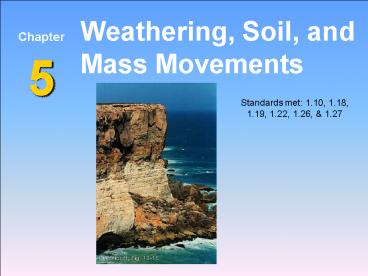Volcanoes and Igneous Activity Earth Chapter 4 PowerPoint PPT Presentation
1 / 15
Title: Volcanoes and Igneous Activity Earth Chapter 4
1
Chapter 5
Weathering, Soil, and Mass Movements
Standards met 1.10, 1.18, 1.19, 1.22, 1.26,
1.27
2
5.1 Weathering the breaking down and changing
of rocks at or near the Earths Surface
? Mechanical weathering occurs when physical
forces break rock into smaller and smaller pieces
without changing the rocks mineral composition.
? In nature three physical process are especially
important causes of weathering frost wedging,
unloading, and biological activity.
3
Increase in Surface Area by Mechanical Weathering
4
MECHANICAL Weathering
1. Frost wedging
- When liquid water freezes it expands
by about 9.
- The mechanical breakup of rock caused by the
expansion of freezing water in cracks and crevices
- Sections of rock that are wedged loose may tumble
into large piles called talus, which typically
form at the base of steep, rocky cliffs.
5
Frost Wedging
6
2. Unloading
- Reduced pressure on igneous rock causes it to
expand and allows slabs of outer rock to break
off in layers in a process called exfoliation. - Exfoliation is common in rock masses made of
granite - Exfoliation domes like the one on the next page
can be found in Stone Mountain, Georgia Liberty
Cap in Yosemite National Park, California.
7
Unloading and Exfoliation of Igneous Rocks
8
- 3. Biological activity
- The activity of organisms, including plants,
burrowing animals, and humans, can also cause
mechanical weathering.
- Plant roots grow into cracks in rock wedge the
rock apart as it grows. - Burrowing animals move rock to the surface
- Deforestation blasting for minerals accelerates
mechanical weathering.
9
CHEMICAL Weathering
? Chemical weathering is the transformation of
rock into one or more new compounds.
10
Water is the most important agent of chemical
weathering.
- It absorbs gases from the atmosphere the
ground. - These dissolved substances then chemically react
with various minerals. - Example Iron oxide is the rust that forms when
iron containing objects are exposed to water.
11
- The carbon dioxide dissolved in water forms
carbonic acid. - Water also absorbs sulfur oxides nitrogen
oxides in the atmosphere and create acid rain.
12
? Spheroidal Weathering causes the corners and
edges of rock to be more rounded.
13
Rate of Weathering
? Two other factors affecting the rate of
weathering are rock characteristics and climate.
1. Rock characteristics
- Mineral composition and solubility
- (granite is more resilient, marble limestone
are less resilient)
- Physical features such as joints/cracks allows
water to penetrate.
14
2. Climate
Temperature and moisture are the most crucial
factors. (frequency of freeze thaw cycles)
Chemical weathering is most effective in areas
with high temperatures and abundant moisture.
Regions with lush vegetation generally have a
thick layer of soil rich in decaying organic
matter that releases acids into the water.
15
? Differential Weathering different part of the
rocks weather at different rates.
Caused by variations in composition
Creates unusual and spectacular rock
formations and landforms

